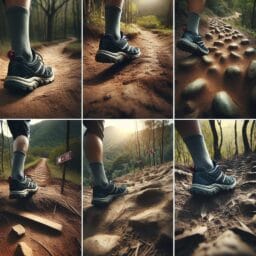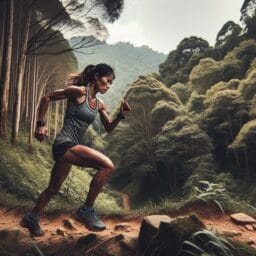
Trail Running 101: Tips and Gear for the Casual Enthusiast
Table of Contents
- Introduction
- Understanding Trail Running
- Preparing for Trail Running
- Essential Gear for Trail Running
- Trail Running Tips
- Joining the Trail Running Community
- Conclusion
- Frequently Asked Questions
Introduction
Have you ever felt the urge to escape the hum of city streets and dive into nature for your morning jog? Well, trail running is your ticket to adventure! It’s not just about swapping concrete for dirt paths; it’s an entirely different experience. When you lace up a pair of rugged trail running shoes, like the Hoka Speedgoat or Altra Lone Peak, you’re gearing up for a journey across unpredictable landscapes. These sneakers are built tough with features like rock plates and stickier rubber soles that hug rocks and roots tighter than a koala hugs a tree!
Trail runners know that every run is like a mini expedition – one where Brooks Cascadias might be better companions than road running shoes. You see, these babies often boast lower heel-to-toe drops for better ground feel, which is crucial when you’re bounding over rocky terrain or zooming through muddy tracks on your Salomon Speedcross.
And let’s chat about those health perks! While your legs power through uneven terrain, they’re getting a killer workout that can’t be matched on flat roads. Plus, the technical trails work wonders for strengthening your core as you balance and stabilize yourself against nature’s little surprises.
But wait – don’t dash off into the wild just yet! Remember to pack smart. Tuck those toes into a foot-hugging toe box and shield them with forefoot rock plates because nobody wants an “ouch” mid-adventure! Stay hydrated with hydration packs essential for longer distances, and dress in quick-drying running shorts and shirts because weather in the great outdoors waits for no runner.
So grab those cushioned trail running shoes (we see you there, Altra Olympus) or even the speedy carbon-plated trail racer if you’ve got the need for speed. Just keep in mind: choosing between lightweight trail running shoes or ones specifically designed for rough terrain can make all the difference between a good run and a great one. Happy trails to all you soon-to-be mountain conquerors out there!
Understanding Trail Running
As you embark on the trail running journey, think of your feet as the intrepid explorers and your trail running shoes as their trusty all-terrain vehicles. When picking your perfect pair, consider the Saucony Peregrine or the Brooks Catamount for their reputation in conquering off-road terrain with ease. These shoes are like loyal sidekicks for your soles, equipped with nifty features such as an ankle collar for added stability and underfoot protection that acts like a shield against those sneaky sticks and stones.
Trail runners world is brimming with terms that might sound like a secret language at first. For example, “technical terrain” refers to those twisty paths where roots tangle and rocks await to test your agility. Or take “heel-to-toe drop,” which isn’t about dropping beats but describes the slope between heel cushioning and toe height in your shoe – something crucial for maintaining comfort over long distances.
Now let’s talk terrain types! There’s more to trails than just dirt paths – there’s a whole spectrum from the road-to-trail shoe friendly gravel tracks to paths that require rugged Hoka Torrent or GTX version shoes designed to keep feet dry even when Mother Nature decides to throw a puddle party. And while exploring muddy terrain may not be everyone’s cup of tea, it sure does add an exciting splash to your run!
Remember those hydration packs? They’re essential companions for longer slogs through nature’s vastness because staying hydrated means keeping up the pace without bonking halfway through your adventure. Speaking of long excursions, technical trails call for quick-drying running shorts and shirts because nobody wants to slog through miles feeling soggy.
If you’re transitioning from hiking shoes or road running shoes into trail shoes, it helps to know that unlike smooth pavement, rocky terrain offers no mercy if you’re not prepared. Enter: rock plates and stickier rubber outsoles found in many trail runners which grip onto surfaces tighter than a determined squirrel scaling a tree!
With each step taken in this sporty pastime comes an appreciation not only for the sense ride underfoot but also for how specifically designed footwear like Altra Lone Peak can elevate performance by complementing foot shape and adjusting to uneven ground feel seamlessly.
To sum up this wild escapade into the world of trail running benefits and tips: lace up those cushioned trail running shoes or grab that speedy carbon-plated trail racer if speed is what you seek. From mountain running highs to navigating rough terrains deftly, remember that choosing gear tailored to both comfort and environment will set you strides ahead on these outdoor treks.
Preparing for Trail Running
Did you know that trail running isn’t just a feast for the eyes but also a full-body buffet of benefits? It’s true—every stride on those rocky, rugged trails is serving up more than just scenic views. Let’s chew over how chomping down on some dirt paths with your trusty trail shoes can be the secret sauce to building endurance like no treadmill can.
Let’s break it down: While road runners world often stick to smooth, even pavements, trail runner warriors take on off-road terrain that makes their muscles sing (sometimes literally with soreness the next day – but it’s the good kind). With every incline conquered and each uneven step navigated, your body learns to endure longer distances, which in turn preps you for all kinds of physical feats. Plus, wearing a pair like Saucony Peregrine or Hoka Speedgoat can add confidence in your footwork so you can tackle those technical terrains without flinching.
Flexibility gets a major boost too! When you’re prancing over rocks roots or side-stepping through twisty trails, it’s like doing yoga mid-run; this kind of adaptive movement keeps your limbs limber and less prone to injury. Runners who’ve only known the embrace of road running shoes might find a surprising ally in those forefoot rock plates and GTX versions designed for dry conditions – they’re not just about keeping feet comfy but also allowing for natural foot shape adjustments as the path demands.
Mentally speaking, hitting the trails is like taking your brain to an outdoor gym. Setting realistic goals before lacing up those lightweight trail running shoes means each run becomes a mission accomplished. Mental toughness comes into play when faced with steep climbs or unforeseen puddles—the outdoors don’t do predictable, so neither does your determination.
In short, whether you’re sporting Altra Lone Peak for their foot-hugging toe box or picking Brooks Cascadia for their ankle collar security through rough terrain, remember that long distances are mastered one step at a time—with each one teaching resilience and strength.
Essential Gear for Trail Running
When you step into the world of trail running, it’s like unlocking a secret level in the game of fitness where the ground rules are quite different. Unlike road running shoes built for speed on smooth surfaces, trail running shoes are the knights in armor; designed to protect your feet from gnarly roots and sneaky stones. They often feature aggressive lugs for superior traction and a sturdy rock plate nestled in the sole to shield against sharp objects—crucial allies when the earth beneath you feels more like an obstacle course.
Choosing the right gear doesn’t stop at footwear; dressing appropriately for trail runs can make or break your experience. Imagine setting out clad in moisture-wicking fabrics that behave like super-absorbent sponges, keeping you dry as you navigate through forests that seem to whisper with each rustling leaf. Layering is also key, allowing runners to adjust their body temperature as they summit hills that challenge their endurance or descend into cool valleys that offer respite from exertion.
Safety is paramount when venturing off-road. Runners should arm themselves with navigation essentials – think GPS devices that track every twist and turn or old-school maps for those who relish a tech-free trot. Hydration systems become lifelines, especially on long distances where water sources are as scarce as flat terrain. And let’s not forget a compact first aid kit – because scrapes and sprains are badges of honor in this sport but still require immediate attention.
So there you have it: equip yourself with trail shoes boasting sticky rubber soles ready to grip onto rocky terrains, clothe yourself in layers that battle against unpredictable weather, keep hydration packs at hand, and remember safety gear like GPS and first aid kits. With these tips under your belt buckle, prepare to embrace the rugged paths where adventure meets health benefits head-on—it’s time to take your fitness quest off-road!
Trail Running Tips
Did you know that conquering hills isn’t just a metaphor for life’s challenges but also a literal perk of trail running? Ascending dunes and darting down dales take more than sheer willpower—it’s about technique. Uphill, it’s wise to lean forward slightly, drive with your arms, and take shorter strides to conserve energy. As for descending, let gravity be your buddy but stay in control; quick, light steps and a focused gaze ahead keep you from tumbling head over heels. Trail runners become adept at these dance-like moves, turning technical terrain into their personal playground.
What happens when the skies open up or the mercury soars? No sweat—well, actually, there’ll be plenty! But with the right approach, even rain can’t dampen your spirits or halt your run. Get yourself a breathable waterproof jacket to fend off moisture without becoming a portable sauna. Hotter temps call for loose-fitting clothing that promotes air circulation so you can sizzle on the trails without overheating. And don’t forget: hydrate, hydrate, hydrate!
Trail shoes aren’t just about getting dirty—they also help you play nice with our green pals outdoors. Whether it’s avoiding trampling sensitive flora or knowing what to do if Bambi crosses your path (no petting please), respecting wildlife habitats ensures these spaces remain pristine for fellow trail enthusiasts.
Lastly, here’s something often learned the hard way: trails have personalities as varied as people! Some are gentle and forgiving like an old friend; others test every bit of your mettle with rocks roots that seem designed by a mischievous goblin. The right pair of trail running shoes makes all the difference on these diverse surfaces—your cushioned trail running shoes might hug rocky terrains lovingly while lightweight trail running shoes prance over softer ground with ease.
So whether you’re battling muddy hills in Salomon Speedcross or cruising comfortable ridgelines in Altra Olympus remember each step weaves together endurance and respect for the land underfoot into one beautiful tapestry known as trail running.
| Action | Technique | Equipment | Environment |
|---|---|---|---|
| Uphill Running | Lean forward slightly, drive with your arms, take shorter strides | – | – |
| Downhill Running | Quick, light steps, a focused gaze ahead | – | – |
| Running in Rain | – | Breathable waterproof jacket | – |
| Running in Heat | Hydrate | Loose-fitting clothing that promotes air circulation | – |
| Respecting Nature | – | Trail shoes | Avoid trampling sensitive flora, respect wildlife |
| Choosing Trail Shoes | – | Cushioned for rocky terrain, lightweight for softer ground | Varied trail surfaces |
| Personal Experience | – | Specific shoe models for conditions (e.g., Salomon Speedcross, Altra Olympus) | Match shoes to trail personality |
Joining the Trail Running Community
Dive headfirst into the community spirit of trail running and you’ll find a whole new level of joy in this sport! Joining local trail running groups not only boosts your social circle, it also catapults your motivation sky-high. Imagine sharing the rocky terrain with fellow Lone Peak enthusiasts or swapping mud-splattered stories with Brooks Cascadia fans post-run—priceless! These running buddies become your real-life ‘trail-pedia,’ filled with insights on every twist and turn of nearby technical trails.
For those who relish a bit of friendly competition, trail races are your golden ticket to adrenaline rushes and personal bests. Whether it’s a sinewy mountain running challenge or a dash through lush forests, the variety is as vast as the open skies above. As you lace up those trusty Hoka Speedgoat shoes, feel the electric buzz at the starting line—a shared energy that fuels every heartbeat on the rugged terrain ahead.
And hey, let’s not forget about tapping into digital trail wisdom from afar! Online forums are like hidden treasure troves where Saucony Peregrine aficionados and Altra Olympus veterans dish out advice. From seeking out the perfect hydration packs to mastering ground feel on uneven terrain—these resources are invaluable for conquering long distances and making sure your feet stay dry, regardless if you’re wearing GTX versions or not.
In essence, connecting with other trail runners means forming bonds stronger than any rock plate underfoot—it’s about paving a path filled with support, shared experiences, and an endless stream of tips from seasoned pros. So don’t run solo; reach out and join vibrant communities both online and in nature’s backyard to truly enrich your trail adventures!

Conclusion
Hit the trails and discover a world where your running shoes are more than just sneakers—they’re your key to unlocking the raw beauty of nature while giving every muscle in your body a high-five. Trail running isn’t just about getting fit; it’s about embarking on journeys through forests that feel enchanted, over hills that whisper tales of adventure, and across terrain that keeps life exciting. With trail shoes like Altra Lone Peak or Brooks Cascadia buckled on, you’ll tread gently over Mother Earth’s contours feeling each rock plate guide you and every stickier rubber sole grip the path ahead. Remember, when choosing your perfect pair, consider not just rugged features for rocky terrains but also breathability for those sunny sprints. Don’t be shy—let your feet taste a bit of mud as you conquer technical trails with gusto! Tailor your gear to stay comfy from toe box to hydration pack for longer distances. Running shorts and shirts? Opt for ones that say ‘adios’ to sweat quick as lightning! And if ever a wild creature crosses paths with you, offer respect but keep your cool—after all, they’re the locals here! So go ahead, friend; chase horizons knowin’ trail runners world is vast with surprises around every bend.




